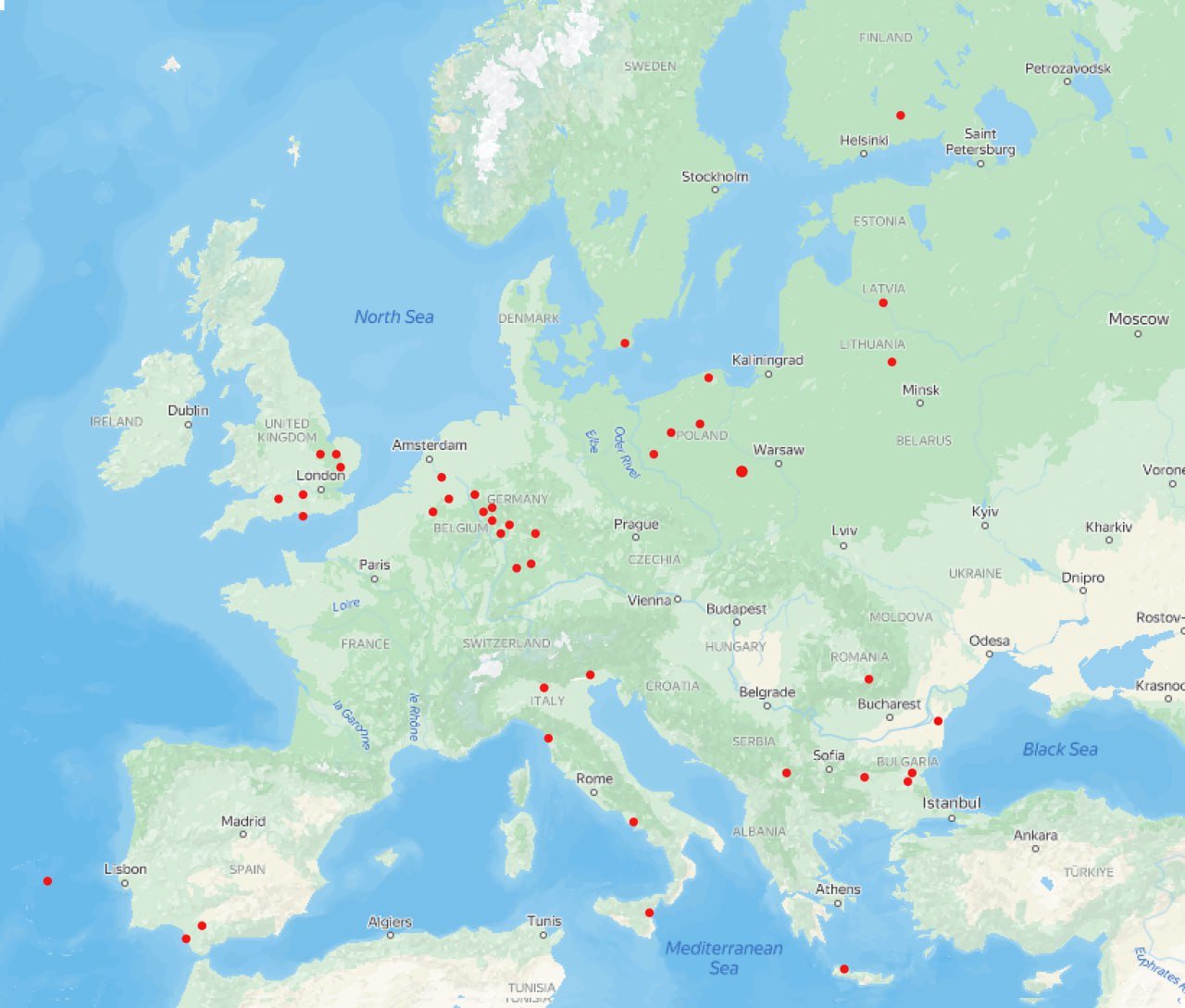ตามรอยย้อนกลับ Supply Chain แร่หายากจากพม่ามหาศาลสู่จีน
______________________________
23 ธันวาคม พ.ศ. 2564 บริษัท China Rare Earth Group Co., Ltd. ก่อตัวขึ้นอย่างเป็นทางการ จากการควบรวมของ 3 กิจการด้านอุตสาหกรรมแร่หายากในจีน China Aluminium Corporation, China Minmetals Corporation และ Ganzhou Rare Earth Group Co., Ltd. เป้าคือพัฒนาอุตสาหกรรมแร่หายาก วิจัยและพัฒนาเทคโนโลยี
China Rare Earth Group อยู่ภายใต้การกำกับดูแลโดยตรงของรัฐ-คณะกรรมการกำกับดูแลและบริหารสินทรัพย์ที่เป็นเจ้าของของสภาแห่งรัฐ ถือหุ้นร้อยละ 31.21 China Aluminium Corporation, China Minmetals Corporation และ Ganzhou Rare Earth Group Co., Ltd. แต่ละบริษัทถือหุ้นร้อยละ 20.33; China Iron and Steel Research Technology Group Co., Ltd. และ Youyan Technology Group Co., Ltd. ถือหุ้นร้อยละ 3.90
ปัจจุบันจีนมีปริมาณการผลิตแร่ธาตุ หายากสูงเป็นอันดับ 1 ของโลกอยู่ที่ 132,000 ตัน คิดเป็นสัดส่วนร้อยละ 63 ของปริมาณการผลิตแร่ธาตุหายากทั่วโลก ซึ่งอยู่ที่ประมาณ 210,000 ตัน โดยประเทศอื่น ๆ ที่มีปริมาณการผลิตแร่ธาตุหายากในลำดับถัดมา ได้แก่ สหรัฐฯ (26,000 ตัน) เมียนมา (22,000 ตัน) ออสเตรเลีย (21,000 ตัน) อินเดีย (3,000 ตัน) รัสเซีย (2,700 ตัน) มาดากัสการ์ (2,000 ตัน) ไทย (1,800 ตัน) บราซิล (1,000 ตัน) เวียดนาม (900 ตัน) และบุรุนดี (600 ตัน)
______________________________
ระฆังกำแพงภาษีลั่นขึ้นห้วงเมษายน 2568 โดยสหรัฐอเมริกา การตอบโต้กลับของจีนเปิดหน้าชก สวนกลับทุกเม็ด รวมถึงได้ขยายการใช้ "แร่หายาก" (rare earths) เป็นเครื่องมือตอบโต้ทางการค้า โดยประกาศจำกัดการส่งออกแร่หายาก 7 ชนิด ซึ่งเป็นวัสดุสำคัญในอุดสาหกรรมเทคโนโลยีขั้นสูง เช่น รถยนต์ไฟฟ้า ไปจนถึงอาวุธยุทโธปกรณ์ โดยเป็นการตอบโต้ต่อมาดรการภาษีนำเข้าของสหรัฐ
สำหรับแร่หายาก 7 ชนิดได้แก่ ชามาเรียม (Samarium) แกโดลิเนียม (Gadolinium) เทอร์เมียม (Terbium) ดิสโพรเซียม (Dysprosium) ลูทีเซียม (Lutetium) สแกนเดียม (Scandium) และอิดเทรียม (Yttrium) สำหรับแร่หายากยอดนิยมอย่าง นี่โอไดเมียม (Neodymium) และ พราเชโอไดเมียม (Praseodymium) ซึ่งใช้ผลิตแม่เหล็กประสิทธิภาพสูง ยังไม่อยู่ในรายชื่อควบคุม
หลังการรัฐประหารปี 2021 การส่งออกแร่ธาตุหายากจากพม่าไปจีนเพิ่มขึ้น 5 เท่า สูงถึง 3.6 พันล้านดอลลาร์สหรัฐ เป็นการการพึ่งพาจีน 90% ของการแปรรูปแร่หายากโลกอยู่ในจีน แบ่งเป็น แร่กลุ่มหายาก (Rare Earth Elements) มูลค่า: 3.6 พันล้านดอลลาร์สหรัฐ (ปี 2025) ส่วนแบ่งการนำเข้า: กว่า 50% ของการนำเข้าแร่หายากทั้งหมดของจีน ชนิดแร่หลัก: เทอร์เบียม (Terbium) และดีสโพรเซียม (Dysprosium) ในกลุ่ม Heavy Rare Earth Elements (HREE) พื้นที่ทำเหมืองหลักที่คะฉิ่น ที่เหมือง Chipwi และ Momauk: มีบ่อแร่มากกว่า 2,700 บ่อ เมือง Panwa: แหล่งผลิตหลักภายใต้การควบคุมของ Kachin Independence Army (KIA) การขยายตัว: จำนวนไซต์ทำเหมืองเพิ่มขึ้น 40% นับตั้งแต่ปี 2021 โดยพื้นที่ KIA: เก็บภาษี 35,000 หยวน/ตัน (ประมาณ 4,800 ดอลลาร์สหรัฐ)
บริษัทจีนผู้รับซื้อหลัก คือ China Rare Earths Group (REGCC) ควบคุมการประมูลแร่กว่า 80% China Northern Rare Earth Group ผู้ประมูลแร่รายใหญ่ของโลก และ JL Mag Rare-Earth: ผู้ผลิตแม่เหล็กถาวรรายใหญ่ ใช้แร่จากพม่าในอุตสาหกรรมยานยนต์ไฟฟ้า และยังมีบริษัท Rising Nonferrous บริษัทที่ได้รับอนุมัติให้นำเข้าแร่หายากจากเมียนมาโดยตรง
นอกจากนั้นก็จะมี China Nonferrous Metal Mining Group (CNMC) รับซื้อ: ทองแดง, นิกเกิล พื้นที่รับซื้อคือเหมือง Monywa ในเขตสะกาย บริษัท China Minmetals Corporation: รับซื้อ: แร่หายาก, ดีบุก, ทังสเตน Aluminum Corporation of China (CHINALCO): รับซื้อ: แร่ที่เกี่ยวข้องกับอะลูมิเนียมและโลหะผสม Yunnan Tin Company: รับซื้อ: ดีบุก เพราะเป็นผู้ผลิตดีบุกรายใหญ่ของจีน Pangang Group: รับซื้อ: ทังสเตน, พลวง เป็นผู้นำในอุตสาหกรรมโลหะหนัก
______________________________
การส่งออกแร่ธาตุจากพม่าไปจีนมีป้อนอุตสาหกรรมหลักที่สร้างรายได้เป็นกอบเป็นกำให้จีน และแน่นอนต้องใช้ฐานของกลุ่มประเทศอาเซียนเป็นตลาดหลักและบายพาสไปยังกลุ่มประเทศที่มีกำแพงภาษีสูงไม่ว่าจะเป็น
• อุตสาหกรรมยานยนต์ไฟฟ้า (Electric Vehicles)แร่ธาตุหายาก เช่น ดิสโพรเซียม (Dysprosium) และเทอร์เบียม (Terbium) ที่นำเข้าจากพม่าใช้เป็นวัตถุดิบสำคัญในการผลิตแม่เหล็กถาวรสำหรับมอเตอร์ในรถยนต์ไฟฟ้า ซึ่งจีนมีความต้องการสูงมากในช่วงหลังเพื่อรองรับการเติบโตของตลาด EV
• อุตสาหกรรมพลังงานลม (Wind Power)แม่เหล็กถาวรที่ผลิตจากแร่ธาตุหายากเหล่านี้ยังถูกใช้ในกังหันลมเพื่อผลิตพลังงานสะอาด ซึ่งเป็นส่วนหนึ่งของนโยบายพลังงานทดแทนของจีน
• อุตสาหกรรมอิเล็กทรอนิกส์ (Electronics)แร่ธาตุหายากจากพม่าถูกนำไปใช้ในชิ้นส่วนอิเล็กทรอนิกส์ เช่น สมาร์ทโฟน คอมพิวเตอร์ และอุปกรณ์อิเล็กทรอนิกส์อื่น ๆ ที่ต้องการแม่เหล็กและวัสดุพิเศษ
• อุตสาหกรรมแม่เหล็กถาวร (Permanent Magnets) บริษัทจีนใหญ่ เช่น China Southern Rare Earth ใช้แร่ธาตุจากพม่าในการผลิตแม่เหล็กถาวรที่เป็นวัตถุดิบสำคัญในหลายอุตสาหกรรม
• อาวุธยุทโธปกรณ์ (Defence Industry) และอุตสาหกรรมอวกาศ และอากาศยาน (Aerospace Industry)
สถานการณ์ความต้องการแร่ธาตุหายากงวดขึ้นเพราะนับวันแร่ธาตุเหล่านั้นย่อมลดลง ตามชื่อเพราะยิ่งหายากขึ้น โดยในช่วงครึ่งแรกของปี 2024 จีนเพิ่มการนำเข้าแร่หายากจากพม่าเกิน 9 เท่าเมื่อเทียบกับปีก่อนหน้า และคิดเป็นกว่า 70% ของแร่ธาตุหายากที่จีนใช้ทั้งหมด ซึ่งทำให้พม่าเป็นแหล่งผลิตแร่หายากที่ใหญ่ที่สุดของจีนในปัจจุบัน
______________________________
ความต้องการสูงและความไม่แน่นอนของซัพพลายเชน โดยเฉพาะในช่วงที่มีความขัดข้องจากสถานการณ์ภูมิรัฐศาสตร์ ทำให้จีนพึ่งพาแหล่งแร่จากต่างประเทศมากขึ้น โดยเฉพาะพม่าเป็นสัดส่วนถึง 70% ของวัตถุดิบที่ใช้ เนื่องจากเหมืองในจีนผลิตไม่เพียงพอและมีข้อจำกัดด้านสิ่งแวดล้อมและนโยบาย
ปัญหาจึงอยู่ที่แร่ธาตุหายากจากพม่าส่วนใหญ่ถูกขุดอย่างผิดกฎหมายและผ่านช่องทางที่ไม่โปร่งใส ทำให้บริษัทจีนที่แปรรูปแร่ไม่สามารถระบุแหล่งที่มาได้ชัดเจน ส่งผลต่อความยั่งยืนและความน่าเชื่อถือของตลาด รวมถึงสร้างปัญหาสุขภาพและสิ่งแวดล้อมต่อพม่าอย่างมหาศาล
หากเจาะพื้นที่การทำเหมืองในรัฐต่าง ๆ การทำเหมืองในเมียนมามักอยู่ในพื้นที่ที่มีความขัดแย้งหรือควบคุมโดยกลุ่มติดอาวุธ ซึ่งมีผลต่อการส่งออกและการจัดการทรัพยากร ดังนี้:
• รัฐคะฉิ่น (Kachin State): แร่หลัก: แร่หายาก (REEs), พลวง, ทองคำ, อิตเทรียม พื้นที่ป่าทางตอนเหนือ อุดมไปด้วยแร่หายาก แต่ได้รับผลกระทบจากความขัดแย้งระหว่างกองทัพเมียนมาและกองทัพปลดปล่อยคะฉิ่น (KIA) ส่วนใหญ่ทำลายสิ่งแวดล้อม น้ำกลายเป็นโคลน และสัตว์ป่าลดลง
• รัฐฉาน (Shan State): แร่หลัก: ดีบุก, ตะกั่ว, สังกะสี, ทังสเตน,ทองคำพื้นที่ที่มีเหมืองดีบุกขนาดใหญ่ เช่น เหมือง Man Maw การควบคุมโดยกลุ่มติดอาวุธที่เชื่อมโยงกับกองทัพเมียนมา ทำให้เงินจากเหมือง สนับสนุนกองทัพ สร้างผลกระทบต่อสิ่งแวดล้อมมหาศาลเช่นกันและลุกลามไปยังประเทศเพื่อนบ้านคือประเทศไทย
• เขตสะกาย (Sagaing Region): แร่หลัก: ทองแดง, นิกเกิล, ทองคำพื้นที่ที่มีการสู้รบหนักระหว่างกองทัพเมียนมาและกองกำลัง PDF
• เขตมัณฑะเลย์ (Mandalay Region): แร่หลัก: แร่หายาก, พลวง, อิตเทรียม, ทองคำพื้นที่ที่มีเหมืองขนาดเล็กกระจายอยู่
• เขตตะนาวศรี (Tanintharyi Region): แร่หลัก: ดีบุก เป็นเหมืองดีบุกขนาดใหญ่ใกล้ชายฝั่ง
• รัฐมอญ (Mon State): แร่หลัก: ทองแดง เป็นเหมืองขนาดเล็กถึงปานกลาง
• รัฐกะยา (Kayah State): แร่หลัก: ตะกั่ว พื้นที่ที่มีความขัดแย้งสูง
______________________________
สอบทานต้นทาง-ย้อนกลับห่วงโซ่อุปทาน (Supply Chain) ของแร่ธาตุจากเมียนมาไปจีนมีลักษณะดังนี้ เริ่มต้นสำรวจแหล่ง แน่นอนฐานข้อมูลมีอยู่แล้วในมือรัฐบาลทหารพม่า และในกำมือเทคโนโลยีจีน ก่อนจะให้บริษัทเอกชนในแต่ละความถนัดของจีน และของพม่าเอง ขุดและแปรรูปเบื้องต้น เหมืองส่วนใหญ่ในพม่าดำเนินการโดยบริษัทท้องถิ่นหรือบริษัทจีนร่วมทุน การแปรรูปขั้นต้น (เช่น การถลุงแร่ดีบุก) มักทำในเมียนมาก่อนส่งออก ส่วนใหญ่ในพื้นที่ขัดแย้งทำให้เกิดปัญหาด้านสิ่งแวดล้อมและการละเมิดสิทธิมนุษยชน
การขนส่ง เส้นทางหลัก: จากเหมืองในรัฐคะฉิ่นและฉานไปยังชายแดนจีน (มณฑลยูนนาน) ผ่านทางรถไฟหรือถนน เช่น เส้นทางรถไฟเจ้าผิ่ว-มูเซ บางส่วนส่งออกผ่านท่าเรือในเขตตะนาวศรีและย่างกุ้ง
การแปรรูปขั้นสูงในจีน ปลายทางคือโรงงานแปรรูปอยู่ในมณฑลกวางตุ้ง, เจียงซู, และแถบเศรษฐกิจแยงซีเกียง โดยแร่หายากถูกกลั่นเป็นโลหะบริสุทธิ์หรือสารประกอบ เช่น นีโอดิเมียมสำหรับแม่เหล็ก หรืออิตเทรียมสำหรับ LED
สายพานอุตสาหกรรมที่ใช้งานแบ่งตามแร่ธาตุอุตสาหกรรมเทคโนโลยี: แร่หายาก (REEs) และดีบุกใช้ในสมาร์ทโฟน, คอมพิวเตอร์, เซมิคอนดักเตอร์ ยานยนต์ไฟฟ้า: แร่หายาก (นีโอดิเมียม, ดิสโพรเซียม) และนิกเกิลใช้ในมอเตอร์และแบตเตอรี่ พลังงานสะอาด: ทังสเตนและพลวงใช้ในกังหันลมและแผงโซลาร์ อุตสาหกรรมทหาร: แร่หายากและพลวงใช้ในขีปนาวุธ, เรดาร์, และเลเซอร์ การก่อสร้างและเครื่องจักร: ทองแดงและสังกะสีใช้ในสายไฟและโครงสร้าง
ความท้าทายในระบบ Supply Chain ส่วนใหญ่คือความขัดแย้งในเมียนมาอาจขัดขวางการขนส่ง จากผลประโยชน์มหาศาลเพื่อนำมาเป็นอาวุธและจุนเจือเสบียงในการรบ ขณะที่นานาชาติได้เรียกร้องให้ตรวจสอบแร่จากพื้นที่ขัดแย้ง แต่จีนเป็นประเทศเดียวที่บังคับให้แยกแร่จากเมียนมาและจีน
______________________________
ล่าสุด กองกำลังเอกราชคะฉิ่น (Kachin Independent Organization, Kachin Independent Army- KIA) ซึ่งได้เป็นเจ้าของใหม่ของเหมืองแร่หายาก หรือแร่แรร์เอิร์ธ (Rare Earth) อนุญาตให้ส่งออกแร่หายากไปยังประเทศจีน โดยเก็บภาษีในอัตรา 30,500 หยวนต่อหนึ่งตัน (ราว 160,000 บาท) พื้นที่แหล่งแร่หายากที่มีมูลค่าหลายพันล้านดอลลาร์ในเขตปางวาและชิพเว (Pang Wa, Chi Pwi) ในรัฐคะฉิ่น ซึ่งกลุ่ม KIA เข้ายึดครองในเดือนตุลาคม พ.ศ. 2567 ได้รับอนุญาตให้ส่งออกแร่หายากไปยังจีนหลังจากควบคุมพื้นที่มาได้ 6 เดือน
สำนักข่าวรอยเตอร์ เมื่อวันที่ 27 มีนาคม 2568 KIO/KIA ได้อนุญาตให้ส่งออกแร่หายากไปยังประเทศจีน โดยเก็บภาษีในอัตรา 30,500 หยวนต่อหนึ่งตัน อย่างไรก็ตาม รายละเอียดอื่น ๆ ในหนังสืออนุญาตของ KIO ยังไม่ได้รับการเปิดเผย เจ้าหน้าที่ KIA เขตปางวาให้ข้อมูลว่าKIO/KIA และรัฐบาลจีน ยังคงเจรจาเกี่ยวกับการใช้จุดผ่านแดนเดียวในการส่งออกแร่หายาก และจนถึงสัปดาห์ที่สองของเดือนเมษายน ยังไม่มีการส่งออกอย่างเป็นทางการ
KIA สามารถควบคุมจุดผ่านแดนทางการค้าระหว่างจีน-พม่าในรัฐคะฉิ่นทั้งหมด ได้แก่ กานปายตี Kan Pai Ti, ล่วยเจ Loi Je และปางวา ขณะนี้ยังอยู่ระหว่างตรวจสอบว่าจะใช้จุดผ่านแดนใดในการส่งออก หลังจากที่ KIA ควบคุมพื้นที่ปางวาและชิพเว รัฐบาลจีนได้มีคำสั่งปิดจุดผ่านแดนทั้งหมด ทำให้บริษัทเหมืองแร่ส่วนใหญ่หยุดดำเนินการ มีเพียงบางบริษัทที่ยังคงขุดแร่ต่อไป เนื่องจากยังมีวัตถุดิบหลงเหลืออยู่
รายงานของ Global Witness ระบุว่า การทำเหมืองแร่แรร์เอิร์ทในพื้นที่ปางวาเริ่มขึ้นในปี 2016 โดยนักธุรกิจชาวจีน ซึ่งส่งออกแร่ไปยังจีนเป็นหลัก ตามข้อมูลปัจจุบัน พม่าติดอันดับ 3 ของประเทศผู้ผลิตแร่แรร์เอิร์ท และคิดเป็น 50% ของการส่งออกแร่หายากทั่วโลก หลังจากการรัฐประหารของกองทัพพม่า การทำเหมืองแร่แรร์เอิร์ทในพื้นที่ปางวาและชิพเวเพิ่มขึ้น 40% และจำนวนเหมืองแร่เพิ่มขึ้นกว่า 300 แห่ง ในปี 2566 เพียงปีเดียว มีการส่งออกแร่หายากไปยังจีนมากถึง 41,700 ตัน สร้างรายได้ถึง 1.4 พันล้านดอลลาร์สหรัฐ
______________________________
สรุปขมวดปม การส่งออกแร่ธาตุจากพม่าไปจีนช่วยเสริมความมั่นคงของซัพพลายเชนแร่หายากในจีน ลดภาวะขาดแคลนและสนับสนุนอุตสาหกรรมเทคโนโลยีขั้นสูง แต่ก็เพิ่มความเสี่ยงด้านความโปร่งใสและความยั่งยืนในตลาดแร่ธาตุของจีน แร่ธาตุหายากจากพม่ามีบทบาทสำคัญในห่วงโซ่อุปทานของจีน โดยเฉพาะในอุตสาหกรรมที่เกี่ยวข้องกับเทคโนโลยีขั้นสูงและพลังงานสะอาด ซึ่งจีนพึ่งพาการนำเข้าแร่จากพม่าเป็นสัดส่วนสูงถึง 70% ของแร่หายากที่ใช้ในประเทศ เหมืองแร่หายากเหล่านี้ทั้งหมด รวมถึงแร่ทองคำ และอื่น ๆ ที่ปักหมุดขุดหลุมร่อนตระแกรง ทุกรัฐในเมียนมาก่อให้เกิดความเสียหายรุนแรงต่อสิ่งแวดล้อมและทรัพยากรธรรมชาติ ป่าเขา แม่น้ำ ลำธาร โดยคนงานบางรายถูกเอารัดเอาเปรียบอย่างโหดร้าย หญิงคนงานถูกล่วงละเมิดทางเพศ และหลายคนได้รับอันตรายทางสุขภาพอย่างร้ายแรงจากสารเคมีที่ใช้ในเหมือง และส่งผลกระทบต่อพื้นที่ที่กว้างขวางขึ้นรวมถึงประเทศไทย และลุ่มแม่น้ำโขงตอนบน คำถามคือจีนมีส่วนสำคัญในการสร้างมลภาวะในพื้นที่ ควรจะร่วมรับผิดชอบหรือไม่ ไม่ใช่การสูบทรัพยากรในพื้นที่แต่ไม่ได้เหลียวแลผลกระทบที่จะตามมา อันจะกลายเป็นการสร้างปัญหาใหญ่ให้กับจีนในอนาคต
อ้างอิง :
https://www.facebook.com/GlobalWitness/ และสำนักข่าวชายขอบ
https://shorturl.asia/6GnqX
ประชาไท
https://prachatai.com/journal/2025/01/111942
______________________________
10 อันดับแร่ธาตุที่ส่งออกจากเมียนมาไปจีน (เรียงตามมูลค่าประเมิน)
1. แร่ดีบุก (Tin)
o มูลค่า: สูงสุด เนื่องจากเมียนมาเป็นผู้ผลิตดีบุกรายใหญ่อันดับ 3 ของโลก และจีนนำเข้า 95% ของหัวแร่ดีบุกจากเมียนมาในปี 2563
o การใช้งาน: ใช้ในอุตสาหกรรมอิเล็กทรอนิกส์ (บัดกรีแผงวงจร), การผลิตโลหะผสม
o พื้นที่เหมือง: รัฐฉาน (Shan State), เขตตะนาวศรี (Tanintharyi Region)
2. แร่หายาก (Rare Earth Elements: REEs)
o มูลค่า: สูง เนื่องจากความต้องการในอุตสาหกรรมเทคโนโลยีขั้นสูงของจีน
o การใช้งาน: ผลิตแม่เหล็กถาวร (Permanent Magnets), แบตเตอรี่รถยนต์ไฟฟ้า, อุปกรณ์เลเซอร์, เซมิคอนดักเตอร์
o พื้นที่เหมือง: รัฐคะฉิ่น (Kachin State), เขตมัณฑะเลย์ (Mandalay Region)
3. ทองแดง (Copper)
o มูลค่า: สูง เนื่องจากราคาทองแดงในตลาดโลกพุ่งสูงหลังรัฐประหาร
o การใช้งาน: สายไฟ, อุปกรณ์อิเล็กทรอนิกส์, การก่อสร้าง
o พื้นที่เหมือง: เขตสะกาย (Sagaing Region), รัฐมอญ (Mon State)
4. ตะกั่ว (Lead)
o มูลค่า: ปานกลางถึงสูง ใช้ในอุตสาหกรรมแบตเตอรี่
o การใช้งาน: แบตเตอรี่ตะกั่ว-กรด, อุตสาหกรรมยานยนต์
o พื้นที่เหมือง: รัฐฉาน, รัฐกะยา (Kayah State)
5. สังกะสี (Zinc)
o มูลค่า: ปานกลาง ใช้ในอุตสาหกรรมเคลือบโลหะ
o การใช้งาน: การชุบกัลวาไนซ์, โลหะผสม
o พื้นที่เหมือง: รัฐฉาน, เขตย่างกุ้ง (Yangon Region)
6. นิกเกิล (Nickel)
o มูลค่า: ปานกลาง เนื่องจากความต้องการในอุตสาหกรรมแบตเตอรี่
o การใช้งาน: แบตเตอรี่ลิเธียม-ไอออน, สแตนเลส
o พื้นที่เหมือง: เขตสะกาย, รัฐฉาน
7. พลวง (Antimony)
o มูลค่า: ปานกลาง ใช้ในอุตสาหกรรมทหารและพลังงาน
o การใช้งาน: สารหน่วงไฟ, โลหะผสม, อุปกรณ์ทหาร
o พื้นที่เหมือง: รัฐคะฉิ่น, เขตมัณฑะเลย์
8. ทังสเตน (Tungsten)
o มูลค่า: ปานกลาง ใช้ในอุตสาหกรรมที่มีความแข็งสูง
o การใช้งาน: โลหะผสม, เครื่องมือตัด, อุปกรณ์ทหาร
o พื้นที่เหมือง: รัฐฉาน, รัฐคะฉิ่น
9. ทองคำ (Gold)
o มูลค่า: ปานกลางถึงสูง ขึ้นอยู่กับราคาตลาดโลก
o การใช้งาน: อุตสาหกรรมอิเล็กทรอนิกส์, เครื่องประดับ
o พื้นที่เหมือง: เขตมัณฑะเลย์, รัฐคะฉิ่น, เขตสะกาย
10. อิตเทรียม (Yttrium)
o มูลค่า: ต่ำถึงปานกลาง แต่มีความสำคัญในอุตสาหกรรมเฉพาะ
o การใช้งาน: สารเรืองแสงใน LED, อุปกรณ์ MRI, เซรามิก
o พื้นที่เหมือง: รัฐคะฉิ่น, เขตมัณฑะเลย์
หมายเหตุ: มูลค่าที่ระบุเป็นการประเมินจากความสำคัญในห่วงโซ่อุปทานและปริมาณการส่งออก เนื่องจากไม่มีข้อมูลตัวเลขที่แน่นอนหลังรัฐประหาร
______________________________
ตามรอยย้อนกลับ Supply Chain แร่หายากจากพม่ามหาศาลสู่จีน
______________________________
23 ธันวาคม พ.ศ. 2564 บริษัท China Rare Earth Group Co., Ltd. ก่อตัวขึ้นอย่างเป็นทางการ จากการควบรวมของ 3 กิจการด้านอุตสาหกรรมแร่หายากในจีน China Aluminium Corporation, China Minmetals Corporation และ Ganzhou Rare Earth Group Co., Ltd. เป้าคือพัฒนาอุตสาหกรรมแร่หายาก วิจัยและพัฒนาเทคโนโลยี
China Rare Earth Group อยู่ภายใต้การกำกับดูแลโดยตรงของรัฐ-คณะกรรมการกำกับดูแลและบริหารสินทรัพย์ที่เป็นเจ้าของของสภาแห่งรัฐ ถือหุ้นร้อยละ 31.21 China Aluminium Corporation, China Minmetals Corporation และ Ganzhou Rare Earth Group Co., Ltd. แต่ละบริษัทถือหุ้นร้อยละ 20.33; China Iron and Steel Research Technology Group Co., Ltd. และ Youyan Technology Group Co., Ltd. ถือหุ้นร้อยละ 3.90
ปัจจุบันจีนมีปริมาณการผลิตแร่ธาตุ หายากสูงเป็นอันดับ 1 ของโลกอยู่ที่ 132,000 ตัน คิดเป็นสัดส่วนร้อยละ 63 ของปริมาณการผลิตแร่ธาตุหายากทั่วโลก ซึ่งอยู่ที่ประมาณ 210,000 ตัน โดยประเทศอื่น ๆ ที่มีปริมาณการผลิตแร่ธาตุหายากในลำดับถัดมา ได้แก่ สหรัฐฯ (26,000 ตัน) เมียนมา (22,000 ตัน) ออสเตรเลีย (21,000 ตัน) อินเดีย (3,000 ตัน) รัสเซีย (2,700 ตัน) มาดากัสการ์ (2,000 ตัน) ไทย (1,800 ตัน) บราซิล (1,000 ตัน) เวียดนาม (900 ตัน) และบุรุนดี (600 ตัน)
______________________________
ระฆังกำแพงภาษีลั่นขึ้นห้วงเมษายน 2568 โดยสหรัฐอเมริกา การตอบโต้กลับของจีนเปิดหน้าชก สวนกลับทุกเม็ด รวมถึงได้ขยายการใช้ "แร่หายาก" (rare earths) เป็นเครื่องมือตอบโต้ทางการค้า โดยประกาศจำกัดการส่งออกแร่หายาก 7 ชนิด ซึ่งเป็นวัสดุสำคัญในอุดสาหกรรมเทคโนโลยีขั้นสูง เช่น รถยนต์ไฟฟ้า ไปจนถึงอาวุธยุทโธปกรณ์ โดยเป็นการตอบโต้ต่อมาดรการภาษีนำเข้าของสหรัฐ
สำหรับแร่หายาก 7 ชนิดได้แก่ ชามาเรียม (Samarium) แกโดลิเนียม (Gadolinium) เทอร์เมียม (Terbium) ดิสโพรเซียม (Dysprosium) ลูทีเซียม (Lutetium) สแกนเดียม (Scandium) และอิดเทรียม (Yttrium) สำหรับแร่หายากยอดนิยมอย่าง นี่โอไดเมียม (Neodymium) และ พราเชโอไดเมียม (Praseodymium) ซึ่งใช้ผลิตแม่เหล็กประสิทธิภาพสูง ยังไม่อยู่ในรายชื่อควบคุม
หลังการรัฐประหารปี 2021 การส่งออกแร่ธาตุหายากจากพม่าไปจีนเพิ่มขึ้น 5 เท่า สูงถึง 3.6 พันล้านดอลลาร์สหรัฐ เป็นการการพึ่งพาจีน 90% ของการแปรรูปแร่หายากโลกอยู่ในจีน แบ่งเป็น แร่กลุ่มหายาก (Rare Earth Elements) มูลค่า: 3.6 พันล้านดอลลาร์สหรัฐ (ปี 2025) ส่วนแบ่งการนำเข้า: กว่า 50% ของการนำเข้าแร่หายากทั้งหมดของจีน ชนิดแร่หลัก: เทอร์เบียม (Terbium) และดีสโพรเซียม (Dysprosium) ในกลุ่ม Heavy Rare Earth Elements (HREE) พื้นที่ทำเหมืองหลักที่คะฉิ่น ที่เหมือง Chipwi และ Momauk: มีบ่อแร่มากกว่า 2,700 บ่อ เมือง Panwa: แหล่งผลิตหลักภายใต้การควบคุมของ Kachin Independence Army (KIA) การขยายตัว: จำนวนไซต์ทำเหมืองเพิ่มขึ้น 40% นับตั้งแต่ปี 2021 โดยพื้นที่ KIA: เก็บภาษี 35,000 หยวน/ตัน (ประมาณ 4,800 ดอลลาร์สหรัฐ)
บริษัทจีนผู้รับซื้อหลัก คือ China Rare Earths Group (REGCC) ควบคุมการประมูลแร่กว่า 80% China Northern Rare Earth Group ผู้ประมูลแร่รายใหญ่ของโลก และ JL Mag Rare-Earth: ผู้ผลิตแม่เหล็กถาวรรายใหญ่ ใช้แร่จากพม่าในอุตสาหกรรมยานยนต์ไฟฟ้า และยังมีบริษัท Rising Nonferrous บริษัทที่ได้รับอนุมัติให้นำเข้าแร่หายากจากเมียนมาโดยตรง
นอกจากนั้นก็จะมี China Nonferrous Metal Mining Group (CNMC) รับซื้อ: ทองแดง, นิกเกิล พื้นที่รับซื้อคือเหมือง Monywa ในเขตสะกาย บริษัท China Minmetals Corporation: รับซื้อ: แร่หายาก, ดีบุก, ทังสเตน Aluminum Corporation of China (CHINALCO): รับซื้อ: แร่ที่เกี่ยวข้องกับอะลูมิเนียมและโลหะผสม Yunnan Tin Company: รับซื้อ: ดีบุก เพราะเป็นผู้ผลิตดีบุกรายใหญ่ของจีน Pangang Group: รับซื้อ: ทังสเตน, พลวง เป็นผู้นำในอุตสาหกรรมโลหะหนัก
______________________________
การส่งออกแร่ธาตุจากพม่าไปจีนมีป้อนอุตสาหกรรมหลักที่สร้างรายได้เป็นกอบเป็นกำให้จีน และแน่นอนต้องใช้ฐานของกลุ่มประเทศอาเซียนเป็นตลาดหลักและบายพาสไปยังกลุ่มประเทศที่มีกำแพงภาษีสูงไม่ว่าจะเป็น
• อุตสาหกรรมยานยนต์ไฟฟ้า (Electric Vehicles)แร่ธาตุหายาก เช่น ดิสโพรเซียม (Dysprosium) และเทอร์เบียม (Terbium) ที่นำเข้าจากพม่าใช้เป็นวัตถุดิบสำคัญในการผลิตแม่เหล็กถาวรสำหรับมอเตอร์ในรถยนต์ไฟฟ้า ซึ่งจีนมีความต้องการสูงมากในช่วงหลังเพื่อรองรับการเติบโตของตลาด EV
• อุตสาหกรรมพลังงานลม (Wind Power)แม่เหล็กถาวรที่ผลิตจากแร่ธาตุหายากเหล่านี้ยังถูกใช้ในกังหันลมเพื่อผลิตพลังงานสะอาด ซึ่งเป็นส่วนหนึ่งของนโยบายพลังงานทดแทนของจีน
• อุตสาหกรรมอิเล็กทรอนิกส์ (Electronics)แร่ธาตุหายากจากพม่าถูกนำไปใช้ในชิ้นส่วนอิเล็กทรอนิกส์ เช่น สมาร์ทโฟน คอมพิวเตอร์ และอุปกรณ์อิเล็กทรอนิกส์อื่น ๆ ที่ต้องการแม่เหล็กและวัสดุพิเศษ
• อุตสาหกรรมแม่เหล็กถาวร (Permanent Magnets) บริษัทจีนใหญ่ เช่น China Southern Rare Earth ใช้แร่ธาตุจากพม่าในการผลิตแม่เหล็กถาวรที่เป็นวัตถุดิบสำคัญในหลายอุตสาหกรรม
• อาวุธยุทโธปกรณ์ (Defence Industry) และอุตสาหกรรมอวกาศ และอากาศยาน (Aerospace Industry)
สถานการณ์ความต้องการแร่ธาตุหายากงวดขึ้นเพราะนับวันแร่ธาตุเหล่านั้นย่อมลดลง ตามชื่อเพราะยิ่งหายากขึ้น โดยในช่วงครึ่งแรกของปี 2024 จีนเพิ่มการนำเข้าแร่หายากจากพม่าเกิน 9 เท่าเมื่อเทียบกับปีก่อนหน้า และคิดเป็นกว่า 70% ของแร่ธาตุหายากที่จีนใช้ทั้งหมด ซึ่งทำให้พม่าเป็นแหล่งผลิตแร่หายากที่ใหญ่ที่สุดของจีนในปัจจุบัน
______________________________
ความต้องการสูงและความไม่แน่นอนของซัพพลายเชน โดยเฉพาะในช่วงที่มีความขัดข้องจากสถานการณ์ภูมิรัฐศาสตร์ ทำให้จีนพึ่งพาแหล่งแร่จากต่างประเทศมากขึ้น โดยเฉพาะพม่าเป็นสัดส่วนถึง 70% ของวัตถุดิบที่ใช้ เนื่องจากเหมืองในจีนผลิตไม่เพียงพอและมีข้อจำกัดด้านสิ่งแวดล้อมและนโยบาย
ปัญหาจึงอยู่ที่แร่ธาตุหายากจากพม่าส่วนใหญ่ถูกขุดอย่างผิดกฎหมายและผ่านช่องทางที่ไม่โปร่งใส ทำให้บริษัทจีนที่แปรรูปแร่ไม่สามารถระบุแหล่งที่มาได้ชัดเจน ส่งผลต่อความยั่งยืนและความน่าเชื่อถือของตลาด รวมถึงสร้างปัญหาสุขภาพและสิ่งแวดล้อมต่อพม่าอย่างมหาศาล
หากเจาะพื้นที่การทำเหมืองในรัฐต่าง ๆ การทำเหมืองในเมียนมามักอยู่ในพื้นที่ที่มีความขัดแย้งหรือควบคุมโดยกลุ่มติดอาวุธ ซึ่งมีผลต่อการส่งออกและการจัดการทรัพยากร ดังนี้:
• รัฐคะฉิ่น (Kachin State): แร่หลัก: แร่หายาก (REEs), พลวง, ทองคำ, อิตเทรียม พื้นที่ป่าทางตอนเหนือ อุดมไปด้วยแร่หายาก แต่ได้รับผลกระทบจากความขัดแย้งระหว่างกองทัพเมียนมาและกองทัพปลดปล่อยคะฉิ่น (KIA) ส่วนใหญ่ทำลายสิ่งแวดล้อม น้ำกลายเป็นโคลน และสัตว์ป่าลดลง
• รัฐฉาน (Shan State): แร่หลัก: ดีบุก, ตะกั่ว, สังกะสี, ทังสเตน,ทองคำพื้นที่ที่มีเหมืองดีบุกขนาดใหญ่ เช่น เหมือง Man Maw การควบคุมโดยกลุ่มติดอาวุธที่เชื่อมโยงกับกองทัพเมียนมา ทำให้เงินจากเหมือง สนับสนุนกองทัพ สร้างผลกระทบต่อสิ่งแวดล้อมมหาศาลเช่นกันและลุกลามไปยังประเทศเพื่อนบ้านคือประเทศไทย
• เขตสะกาย (Sagaing Region): แร่หลัก: ทองแดง, นิกเกิล, ทองคำพื้นที่ที่มีการสู้รบหนักระหว่างกองทัพเมียนมาและกองกำลัง PDF
• เขตมัณฑะเลย์ (Mandalay Region): แร่หลัก: แร่หายาก, พลวง, อิตเทรียม, ทองคำพื้นที่ที่มีเหมืองขนาดเล็กกระจายอยู่
• เขตตะนาวศรี (Tanintharyi Region): แร่หลัก: ดีบุก เป็นเหมืองดีบุกขนาดใหญ่ใกล้ชายฝั่ง
• รัฐมอญ (Mon State): แร่หลัก: ทองแดง เป็นเหมืองขนาดเล็กถึงปานกลาง
• รัฐกะยา (Kayah State): แร่หลัก: ตะกั่ว พื้นที่ที่มีความขัดแย้งสูง
______________________________
สอบทานต้นทาง-ย้อนกลับห่วงโซ่อุปทาน (Supply Chain) ของแร่ธาตุจากเมียนมาไปจีนมีลักษณะดังนี้ เริ่มต้นสำรวจแหล่ง แน่นอนฐานข้อมูลมีอยู่แล้วในมือรัฐบาลทหารพม่า และในกำมือเทคโนโลยีจีน ก่อนจะให้บริษัทเอกชนในแต่ละความถนัดของจีน และของพม่าเอง ขุดและแปรรูปเบื้องต้น เหมืองส่วนใหญ่ในพม่าดำเนินการโดยบริษัทท้องถิ่นหรือบริษัทจีนร่วมทุน การแปรรูปขั้นต้น (เช่น การถลุงแร่ดีบุก) มักทำในเมียนมาก่อนส่งออก ส่วนใหญ่ในพื้นที่ขัดแย้งทำให้เกิดปัญหาด้านสิ่งแวดล้อมและการละเมิดสิทธิมนุษยชน
การขนส่ง เส้นทางหลัก: จากเหมืองในรัฐคะฉิ่นและฉานไปยังชายแดนจีน (มณฑลยูนนาน) ผ่านทางรถไฟหรือถนน เช่น เส้นทางรถไฟเจ้าผิ่ว-มูเซ บางส่วนส่งออกผ่านท่าเรือในเขตตะนาวศรีและย่างกุ้ง
การแปรรูปขั้นสูงในจีน ปลายทางคือโรงงานแปรรูปอยู่ในมณฑลกวางตุ้ง, เจียงซู, และแถบเศรษฐกิจแยงซีเกียง โดยแร่หายากถูกกลั่นเป็นโลหะบริสุทธิ์หรือสารประกอบ เช่น นีโอดิเมียมสำหรับแม่เหล็ก หรืออิตเทรียมสำหรับ LED
สายพานอุตสาหกรรมที่ใช้งานแบ่งตามแร่ธาตุอุตสาหกรรมเทคโนโลยี: แร่หายาก (REEs) และดีบุกใช้ในสมาร์ทโฟน, คอมพิวเตอร์, เซมิคอนดักเตอร์ ยานยนต์ไฟฟ้า: แร่หายาก (นีโอดิเมียม, ดิสโพรเซียม) และนิกเกิลใช้ในมอเตอร์และแบตเตอรี่ พลังงานสะอาด: ทังสเตนและพลวงใช้ในกังหันลมและแผงโซลาร์ อุตสาหกรรมทหาร: แร่หายากและพลวงใช้ในขีปนาวุธ, เรดาร์, และเลเซอร์ การก่อสร้างและเครื่องจักร: ทองแดงและสังกะสีใช้ในสายไฟและโครงสร้าง
ความท้าทายในระบบ Supply Chain ส่วนใหญ่คือความขัดแย้งในเมียนมาอาจขัดขวางการขนส่ง จากผลประโยชน์มหาศาลเพื่อนำมาเป็นอาวุธและจุนเจือเสบียงในการรบ ขณะที่นานาชาติได้เรียกร้องให้ตรวจสอบแร่จากพื้นที่ขัดแย้ง แต่จีนเป็นประเทศเดียวที่บังคับให้แยกแร่จากเมียนมาและจีน
______________________________
ล่าสุด กองกำลังเอกราชคะฉิ่น (Kachin Independent Organization, Kachin Independent Army- KIA) ซึ่งได้เป็นเจ้าของใหม่ของเหมืองแร่หายาก หรือแร่แรร์เอิร์ธ (Rare Earth) อนุญาตให้ส่งออกแร่หายากไปยังประเทศจีน โดยเก็บภาษีในอัตรา 30,500 หยวนต่อหนึ่งตัน (ราว 160,000 บาท) พื้นที่แหล่งแร่หายากที่มีมูลค่าหลายพันล้านดอลลาร์ในเขตปางวาและชิพเว (Pang Wa, Chi Pwi) ในรัฐคะฉิ่น ซึ่งกลุ่ม KIA เข้ายึดครองในเดือนตุลาคม พ.ศ. 2567 ได้รับอนุญาตให้ส่งออกแร่หายากไปยังจีนหลังจากควบคุมพื้นที่มาได้ 6 เดือน
สำนักข่าวรอยเตอร์ เมื่อวันที่ 27 มีนาคม 2568 KIO/KIA ได้อนุญาตให้ส่งออกแร่หายากไปยังประเทศจีน โดยเก็บภาษีในอัตรา 30,500 หยวนต่อหนึ่งตัน อย่างไรก็ตาม รายละเอียดอื่น ๆ ในหนังสืออนุญาตของ KIO ยังไม่ได้รับการเปิดเผย เจ้าหน้าที่ KIA เขตปางวาให้ข้อมูลว่าKIO/KIA และรัฐบาลจีน ยังคงเจรจาเกี่ยวกับการใช้จุดผ่านแดนเดียวในการส่งออกแร่หายาก และจนถึงสัปดาห์ที่สองของเดือนเมษายน ยังไม่มีการส่งออกอย่างเป็นทางการ
KIA สามารถควบคุมจุดผ่านแดนทางการค้าระหว่างจีน-พม่าในรัฐคะฉิ่นทั้งหมด ได้แก่ กานปายตี Kan Pai Ti, ล่วยเจ Loi Je และปางวา ขณะนี้ยังอยู่ระหว่างตรวจสอบว่าจะใช้จุดผ่านแดนใดในการส่งออก หลังจากที่ KIA ควบคุมพื้นที่ปางวาและชิพเว รัฐบาลจีนได้มีคำสั่งปิดจุดผ่านแดนทั้งหมด ทำให้บริษัทเหมืองแร่ส่วนใหญ่หยุดดำเนินการ มีเพียงบางบริษัทที่ยังคงขุดแร่ต่อไป เนื่องจากยังมีวัตถุดิบหลงเหลืออยู่
รายงานของ Global Witness ระบุว่า การทำเหมืองแร่แรร์เอิร์ทในพื้นที่ปางวาเริ่มขึ้นในปี 2016 โดยนักธุรกิจชาวจีน ซึ่งส่งออกแร่ไปยังจีนเป็นหลัก ตามข้อมูลปัจจุบัน พม่าติดอันดับ 3 ของประเทศผู้ผลิตแร่แรร์เอิร์ท และคิดเป็น 50% ของการส่งออกแร่หายากทั่วโลก หลังจากการรัฐประหารของกองทัพพม่า การทำเหมืองแร่แรร์เอิร์ทในพื้นที่ปางวาและชิพเวเพิ่มขึ้น 40% และจำนวนเหมืองแร่เพิ่มขึ้นกว่า 300 แห่ง ในปี 2566 เพียงปีเดียว มีการส่งออกแร่หายากไปยังจีนมากถึง 41,700 ตัน สร้างรายได้ถึง 1.4 พันล้านดอลลาร์สหรัฐ
______________________________
สรุปขมวดปม การส่งออกแร่ธาตุจากพม่าไปจีนช่วยเสริมความมั่นคงของซัพพลายเชนแร่หายากในจีน ลดภาวะขาดแคลนและสนับสนุนอุตสาหกรรมเทคโนโลยีขั้นสูง แต่ก็เพิ่มความเสี่ยงด้านความโปร่งใสและความยั่งยืนในตลาดแร่ธาตุของจีน แร่ธาตุหายากจากพม่ามีบทบาทสำคัญในห่วงโซ่อุปทานของจีน โดยเฉพาะในอุตสาหกรรมที่เกี่ยวข้องกับเทคโนโลยีขั้นสูงและพลังงานสะอาด ซึ่งจีนพึ่งพาการนำเข้าแร่จากพม่าเป็นสัดส่วนสูงถึง 70% ของแร่หายากที่ใช้ในประเทศ เหมืองแร่หายากเหล่านี้ทั้งหมด รวมถึงแร่ทองคำ และอื่น ๆ ที่ปักหมุดขุดหลุมร่อนตระแกรง ทุกรัฐในเมียนมาก่อให้เกิดความเสียหายรุนแรงต่อสิ่งแวดล้อมและทรัพยากรธรรมชาติ ป่าเขา แม่น้ำ ลำธาร โดยคนงานบางรายถูกเอารัดเอาเปรียบอย่างโหดร้าย หญิงคนงานถูกล่วงละเมิดทางเพศ และหลายคนได้รับอันตรายทางสุขภาพอย่างร้ายแรงจากสารเคมีที่ใช้ในเหมือง และส่งผลกระทบต่อพื้นที่ที่กว้างขวางขึ้นรวมถึงประเทศไทย และลุ่มแม่น้ำโขงตอนบน คำถามคือจีนมีส่วนสำคัญในการสร้างมลภาวะในพื้นที่ ควรจะร่วมรับผิดชอบหรือไม่ ไม่ใช่การสูบทรัพยากรในพื้นที่แต่ไม่ได้เหลียวแลผลกระทบที่จะตามมา อันจะกลายเป็นการสร้างปัญหาใหญ่ให้กับจีนในอนาคต
อ้างอิง : https://www.facebook.com/GlobalWitness/ และสำนักข่าวชายขอบ
https://shorturl.asia/6GnqX
ประชาไท https://prachatai.com/journal/2025/01/111942
______________________________
10 อันดับแร่ธาตุที่ส่งออกจากเมียนมาไปจีน (เรียงตามมูลค่าประเมิน)
1. แร่ดีบุก (Tin)
o มูลค่า: สูงสุด เนื่องจากเมียนมาเป็นผู้ผลิตดีบุกรายใหญ่อันดับ 3 ของโลก และจีนนำเข้า 95% ของหัวแร่ดีบุกจากเมียนมาในปี 2563
o การใช้งาน: ใช้ในอุตสาหกรรมอิเล็กทรอนิกส์ (บัดกรีแผงวงจร), การผลิตโลหะผสม
o พื้นที่เหมือง: รัฐฉาน (Shan State), เขตตะนาวศรี (Tanintharyi Region)
2. แร่หายาก (Rare Earth Elements: REEs)
o มูลค่า: สูง เนื่องจากความต้องการในอุตสาหกรรมเทคโนโลยีขั้นสูงของจีน
o การใช้งาน: ผลิตแม่เหล็กถาวร (Permanent Magnets), แบตเตอรี่รถยนต์ไฟฟ้า, อุปกรณ์เลเซอร์, เซมิคอนดักเตอร์
o พื้นที่เหมือง: รัฐคะฉิ่น (Kachin State), เขตมัณฑะเลย์ (Mandalay Region)
3. ทองแดง (Copper)
o มูลค่า: สูง เนื่องจากราคาทองแดงในตลาดโลกพุ่งสูงหลังรัฐประหาร
o การใช้งาน: สายไฟ, อุปกรณ์อิเล็กทรอนิกส์, การก่อสร้าง
o พื้นที่เหมือง: เขตสะกาย (Sagaing Region), รัฐมอญ (Mon State)
4. ตะกั่ว (Lead)
o มูลค่า: ปานกลางถึงสูง ใช้ในอุตสาหกรรมแบตเตอรี่
o การใช้งาน: แบตเตอรี่ตะกั่ว-กรด, อุตสาหกรรมยานยนต์
o พื้นที่เหมือง: รัฐฉาน, รัฐกะยา (Kayah State)
5. สังกะสี (Zinc)
o มูลค่า: ปานกลาง ใช้ในอุตสาหกรรมเคลือบโลหะ
o การใช้งาน: การชุบกัลวาไนซ์, โลหะผสม
o พื้นที่เหมือง: รัฐฉาน, เขตย่างกุ้ง (Yangon Region)
6. นิกเกิล (Nickel)
o มูลค่า: ปานกลาง เนื่องจากความต้องการในอุตสาหกรรมแบตเตอรี่
o การใช้งาน: แบตเตอรี่ลิเธียม-ไอออน, สแตนเลส
o พื้นที่เหมือง: เขตสะกาย, รัฐฉาน
7. พลวง (Antimony)
o มูลค่า: ปานกลาง ใช้ในอุตสาหกรรมทหารและพลังงาน
o การใช้งาน: สารหน่วงไฟ, โลหะผสม, อุปกรณ์ทหาร
o พื้นที่เหมือง: รัฐคะฉิ่น, เขตมัณฑะเลย์
8. ทังสเตน (Tungsten)
o มูลค่า: ปานกลาง ใช้ในอุตสาหกรรมที่มีความแข็งสูง
o การใช้งาน: โลหะผสม, เครื่องมือตัด, อุปกรณ์ทหาร
o พื้นที่เหมือง: รัฐฉาน, รัฐคะฉิ่น
9. ทองคำ (Gold)
o มูลค่า: ปานกลางถึงสูง ขึ้นอยู่กับราคาตลาดโลก
o การใช้งาน: อุตสาหกรรมอิเล็กทรอนิกส์, เครื่องประดับ
o พื้นที่เหมือง: เขตมัณฑะเลย์, รัฐคะฉิ่น, เขตสะกาย
10. อิตเทรียม (Yttrium)
o มูลค่า: ต่ำถึงปานกลาง แต่มีความสำคัญในอุตสาหกรรมเฉพาะ
o การใช้งาน: สารเรืองแสงใน LED, อุปกรณ์ MRI, เซรามิก
o พื้นที่เหมือง: รัฐคะฉิ่น, เขตมัณฑะเลย์
หมายเหตุ: มูลค่าที่ระบุเป็นการประเมินจากความสำคัญในห่วงโซ่อุปทานและปริมาณการส่งออก เนื่องจากไม่มีข้อมูลตัวเลขที่แน่นอนหลังรัฐประหาร
______________________________











